Family level variation in Wolbachia-mediated dengue virus blocking in Aedes aegypti
- PMID: 29282144
- PMCID: PMC5746003
- DOI: 10.1186/s13071-017-2589-3
Family level variation in Wolbachia-mediated dengue virus blocking in Aedes aegypti
Abstract
Background: The mosquito vector Aedes aegypti is responsible for transmitting a range of arboviruses including dengue (DENV) and Zika (ZIKV). The global reach of these viruses is increasing due to an expansion of the mosquito's geographic range and increasing urbanization and human travel. Vector control remains the primary means for limiting these diseases. Wolbachia pipientis is an endosymbiotic bacterium of insects that has the ability to block the replication of pathogens, including flaviviruses such as DENV or ZIKV, inside the body of the vector. A strain of Wolbachia called wMel is currently being released into wild mosquito populations to test its potential to limit virus transmission to humans. The mechanism that underpins the virus blocking effect, however, remains elusive.
Methods: We used a modified full-sib breeding design in conjunction with vector competence assays in wildtype and wMel-infected Aedes aegypti collected from the field. All individuals were injected with DENV-2 intrathoracically at 5-6 days of age. Tissues were dissected 7 days post-infection to allow quantification of DENV and Wolbachia loads.
Results: We show the first evidence of family level variation in Wolbachia-mediated blocking in mosquitoes. This variation may stem from either genetic contributions from the mosquito and Wolbachia genomes or environmental influences on Wolbachia. In these families, we also tested for correlations between strength of blocking and expression level for several insect immunity genes with possible roles in blocking, identifying two genes of interest (AGO2 and SCP-2).
Conclusions: In this study we show variation in Wolbachia-mediated DENV blocking in Aedes aegypti that may arise from genetic contributions and environmental influences on the mosquito-Wolbachia association. This suggests that Wolbachia-mediated blocking may have the ability to evolve through time or be expressed differentially across environments. The long-term efficacy of Wolbachia in the field will be dependent on the stability of blocking. Understanding the mechanism of blocking will be necessary for successful development of strategies that counter the emergence of evolved resistance or variation in its expression under diverse field conditions.
Keywords: Aedes; Dengue virus; Evolution; Genetic variation; Wolbachia.
Conflict of interest statement
Ethics approval and consent to participate
The ET300 DENV strain used in the study was received from researchers associated with Queensland Health (QH), Australia/University of Queensland (UQ). IRB approval was obtained from UQ. Patient data were anonymized by QH. The Monash University Human Research Ethics Committee gave ethical approval (permit CF11/0766-2011000387) for the experimental research. Human volunteer blood-feeders were provided and agreed upon written informed consent prior to the study.
Consent for publication
Not applicable
Competing interests
The authors declare that they have no competing interests.
Publisher’s Note
Springer Nature remains neutral with regard to jurisdictional claims in published maps and institutional affiliations.
Figures
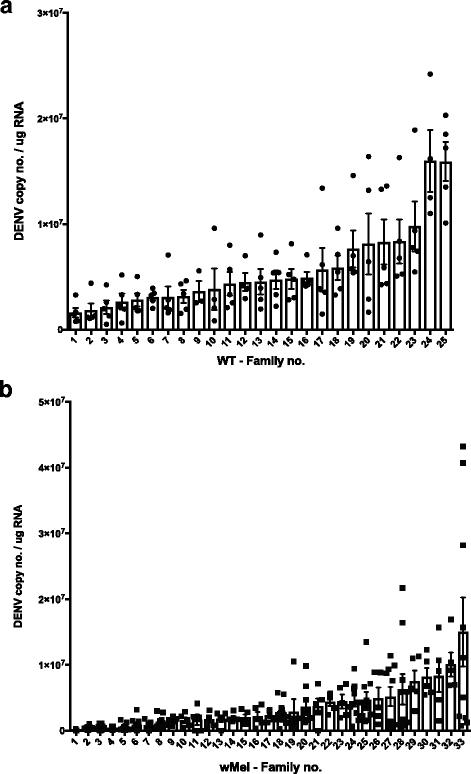

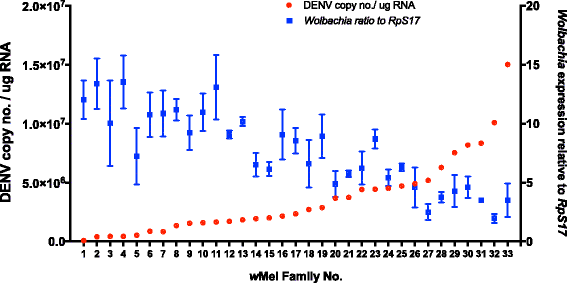
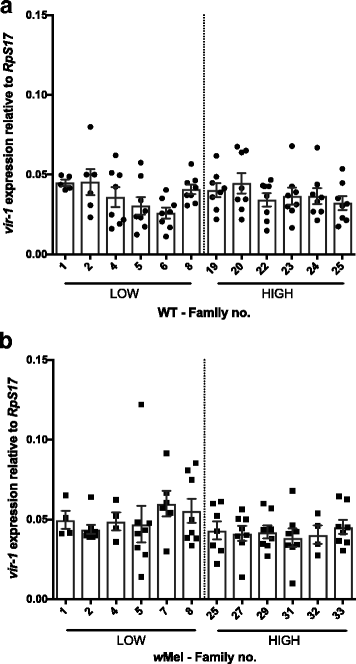

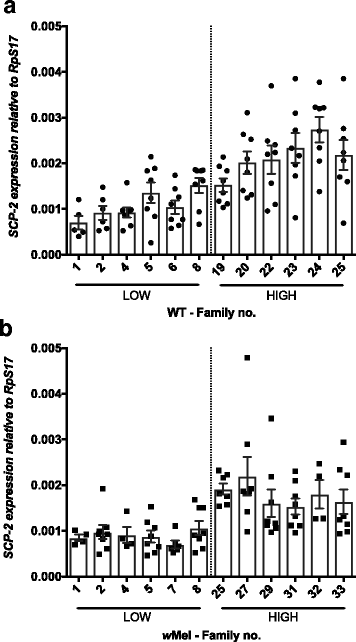
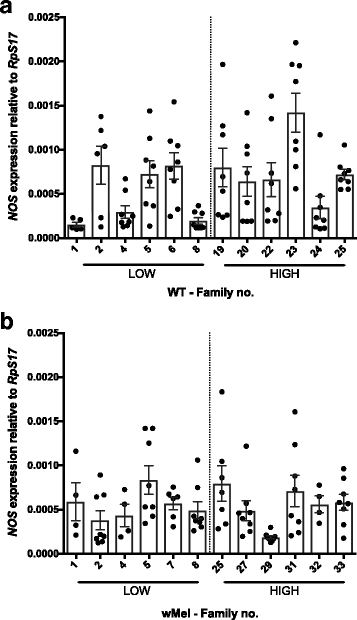
Similar articles
-
Wolbachia-Based Dengue Virus Inhibition Is Not Tissue-Specific in Aedes aegypti.PLoS Negl Trop Dis. 2016 Nov 17;10(11):e0005145. doi: 10.1371/journal.pntd.0005145. eCollection 2016 Nov. PLoS Negl Trop Dis. 2016. PMID: 27855218 Free PMC article.
-
Wolbachia Reduces the Transmission Potential of Dengue-Infected Aedes aegypti.PLoS Negl Trop Dis. 2015 Jun 26;9(6):e0003894. doi: 10.1371/journal.pntd.0003894. eCollection 2015. PLoS Negl Trop Dis. 2015. PMID: 26115104 Free PMC article.
-
The effects of DENV serotype competition and co-infection on viral kinetics in Wolbachia-infected and uninfected Aedes aegypti mosquitoes.Parasit Vectors. 2021 Jun 9;14(1):314. doi: 10.1186/s13071-021-04816-0. Parasit Vectors. 2021. PMID: 34108021 Free PMC article.
-
Wolbachia-mediated virus blocking in the mosquito vector Aedes aegypti.Curr Opin Insect Sci. 2017 Aug;22:37-44. doi: 10.1016/j.cois.2017.05.005. Epub 2017 May 10. Curr Opin Insect Sci. 2017. PMID: 28805637 Review.
-
Mission Accomplished? We Need a Guide to the 'Post Release' World of Wolbachia for Aedes-borne Disease Control.Trends Parasitol. 2018 Mar;34(3):217-226. doi: 10.1016/j.pt.2017.11.011. Epub 2018 Jan 23. Trends Parasitol. 2018. PMID: 29396201 Review.
Cited by
-
Assessing the role of family level variation and heat shock gene expression in the thermal stress response of the mosquito Aedes aegypti.Philos Trans R Soc Lond B Biol Sci. 2023 Mar 27;378(1873):20220011. doi: 10.1098/rstb.2022.0011. Epub 2023 Feb 6. Philos Trans R Soc Lond B Biol Sci. 2023. PMID: 36744557 Free PMC article.
-
Using genetic variation in Aedes aegypti to identify candidate anti-dengue virus genes.BMC Infect Dis. 2019 Jul 4;19(1):580. doi: 10.1186/s12879-019-4212-z. BMC Infect Dis. 2019. PMID: 31272403 Free PMC article.
-
A wAlbB Wolbachia Transinfection Displays Stable Phenotypic Effects across Divergent Aedes aegypti Mosquito Backgrounds.Appl Environ Microbiol. 2021 Sep 28;87(20):e0126421. doi: 10.1128/AEM.01264-21. Epub 2021 Aug 11. Appl Environ Microbiol. 2021. PMID: 34379518 Free PMC article.
-
Selection on Aedes aegypti alters Wolbachia-mediated dengue virus blocking and fitness.Nat Microbiol. 2019 Nov;4(11):1832-1839. doi: 10.1038/s41564-019-0533-3. Epub 2019 Aug 26. Nat Microbiol. 2019. PMID: 31451771 Free PMC article.
-
Host-associated microbiomes are predicted by immune system complexity and climate.Genome Biol. 2020 Feb 3;21(1):23. doi: 10.1186/s13059-019-1908-8. Genome Biol. 2020. PMID: 32014020 Free PMC article.
References
Publication types
MeSH terms
Grants and funding
LinkOut - more resources
Full Text Sources
Other Literature Sources

